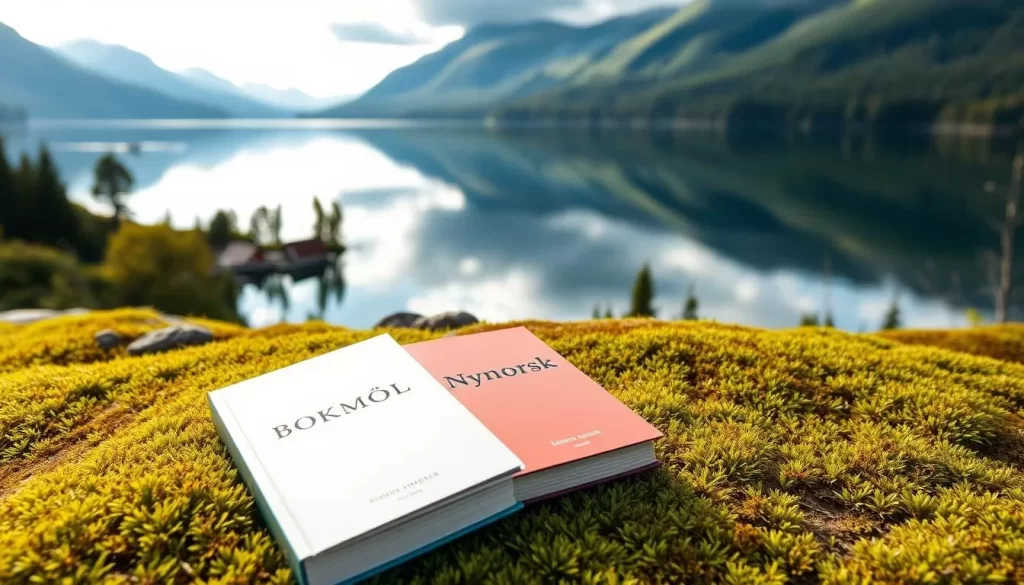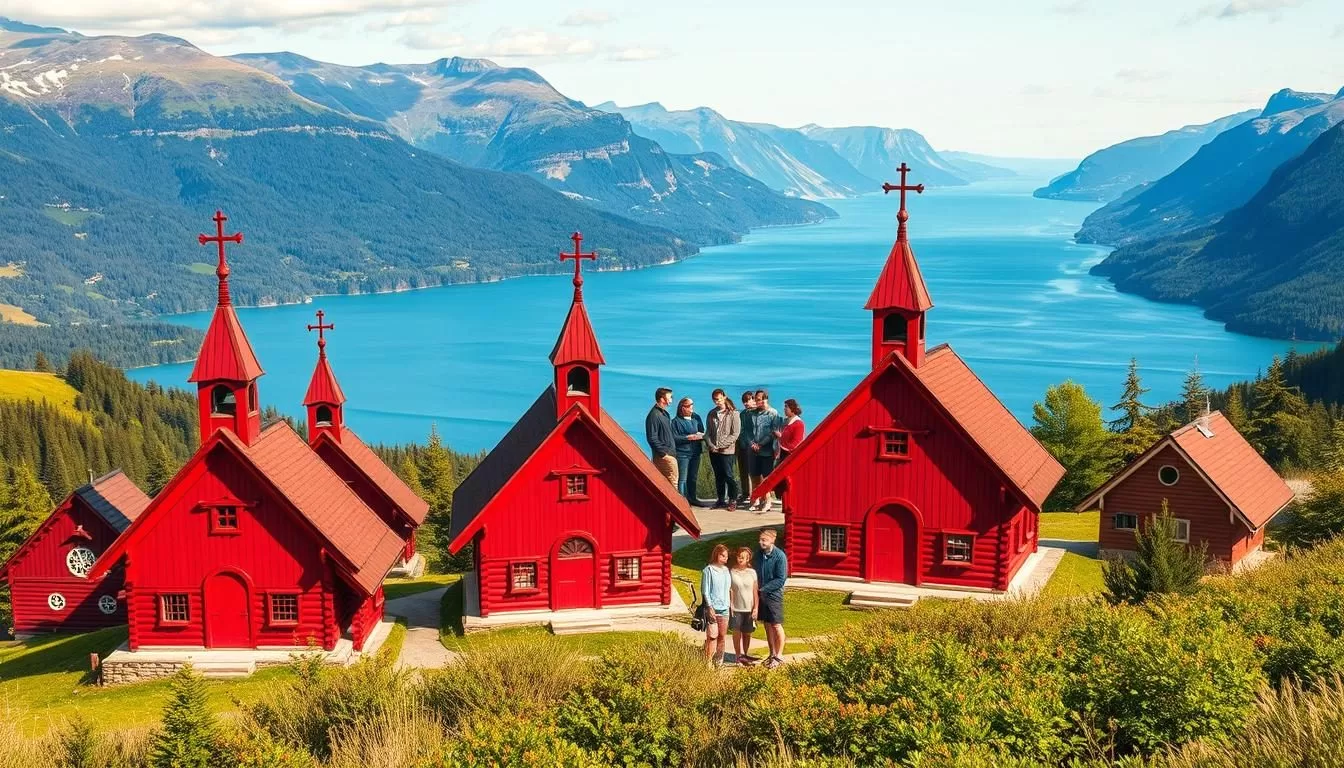✓ Accommodations✓ Flights✓ Rental Cars✓ Tours & Activities
Norway’s linguistic landscape is both fascinating and diverse. The Norwegian language is the primary mode of communication, spoken by about 95% of the population as their first language. It has two written forms: Bokmål and Nynorsk, each with its own historical and cultural significance.
English also plays a significant role, with approximately 88% of the population being proficient in it. This makes it the second most widely used language in the country. Whether you’re exploring urban areas or rural regions, you’ll find that most locals are comfortable communicating in English.
Understanding Norway’s language policy helps you appreciate its cultural richness. From Bokmål’s dominance in schools to Nynorsk’s regional usage, each form reflects the nation’s heritage. This section sets the stage for a deeper dive into Norway’s unique linguistic profile.
Introduction: Norway’s Linguistic Landscape
The linguistic tapestry of Norway is a blend of history, culture, and regional nuances. From the rugged fjords to bustling cities, the way people communicate reflects a deep connection to their heritage. This section explores the rich diversity of dialects and written forms that shape the nation’s identity.
Overview of Norway’s Language Diversity
Norway’s dialects are as varied as its landscapes. Eastern dialects, like those around Oslo, dominate the region and are often used in media and business. These dialects have a flat intonation, making them distinct from others. In contrast, Western dialects are known for their clear, taut consonants, reflecting a maritime influence.
Northern dialects carry a unique melody, influenced by the Sami language. This makes them challenging for outsiders to understand but rich in cultural significance. Southern dialects, shaped by historical interactions with Danish and Swedish, have a softer pronunciation, especially with the ‘r’ sound.
Significance for Residents and Visitors
For residents, dialects are a source of pride and identity. They connect people to their local heritage and history. Visitors, on the other hand, might find the variations fascinating but manageable, as English is widely understood.
The two written forms, Bokmål and Nynorsk, add another layer to this complexity. Bokmål is used by about 93% of the population, while Nynorsk is preferred by 7%. Both forms reflect the nation’s linguistic evolution, from Old Norse roots to modern standards.
“Language is the road map of a culture. It tells you where its people come from and where they are going.”
Understanding these elements helps you appreciate the depth of Norway’s linguistic landscape. Whether you’re exploring urban centers or rural areas, the dialects and written forms offer a glimpse into the country’s rich cultural fabric.
Historical Perspectives on Norwegian Language Development
From its ancient origins to modern forms, the Norwegian language tells a story of resilience and adaptation. Its development reflects centuries of influence, from Old Norse roots to Danish rule and beyond. Understanding this history helps you appreciate how it became the standard it is today.
Roots in Old Norse and Old Norwegian
The foundation of Norwegian lies in Old Norse, the language of the Vikings. This ancient tongue was spoken across Scandinavia and shaped early dialects. Over time, Old Norwegian emerged, evolving into distinct regional forms. These dialects remain a vital part of the nation’s linguistic identity.
The Impact of Danish Rule and the Language Struggle
Danish rule from the 14th to 19th centuries left a lasting mark. During this period, Danish became the dominant written language, while local dialects persisted. This dual system created a linguistic struggle, as people sought to reclaim their heritage. The Royal Frederik University in Oslo endorsed the idea that Danish in the area should be considered Norwegian.

The Evolution from Riksmål to Bokmål and Nynorsk
In the 19th century, efforts to Norwegianize Danish led to the creation of Riksmål. This form later evolved into Bokmål, now used by 85–90% of the population. Meanwhile, Nynorsk, based on rural dialects, emerged as an alternative. Today, both forms coexist, reflecting the nation’s linguistic diversity.
| Language Form | Usage Today |
|---|---|
| Bokmål | 85–90% |
| Nynorsk | 10–15% |
The journey from Old Norse to modern bokmål nynorsk highlights the resilience of the Norwegian language. Each stage reflects the nation’s ability to adapt while preserving its unique identity.
Exploring Regional Variations and Dialects
The regional dialects and minority tongues of Norway paint a vivid picture of its cultural diversity. From the fjords to the cities, each group has its own unique way of communicating. These dialects are not just linguistic variations but also markers of identity and heritage.

Understanding Local Dialects and Minority Languages
Norway’s dialects are grouped into four main categories: Eastern, Western, Central, and Northern. Each group has distinct features that set it apart. For example, the Eastern dialect, known as Østnorsk, is the most commonly heard in media. It’s characterized by clear pronunciation of certain sounds, making it easier for learners to understand.
In contrast, the Western dialect, or Vestlandsk, features hard consonants and a unique “skarre-r” sound. This form Norwegian takes on a musical quality, reflecting the region’s maritime history. Meanwhile, the Northern dialects, or Nordnorsk, are known for their colorful vocabulary and vowel changes.
Minority languages like Sami and Kven add another layer to this linguistic mosaic. The kven language, spoken by between 5,000 and 8,000 people in northeastern regions, is a testament to the area’s historical ties to Finland. Similarly, Sami languages, though spoken by smaller numbers, hold deep cultural significance.
Urban areas often use a more standardized form Norwegian, while rural regions preserve older dialects. This contrast highlights the balance between tradition and modernity in spoken Norway. Whether you’re in a bustling city or a quiet village, you’ll notice how language reflects the local way of life.
For many, these dialects are a second language, learned alongside the standard forms. This dynamic enriches the linguistic landscape, making it a fascinating subject for both residents and visitors. Understanding these variations offers a deeper appreciation of the country’s cultural fabric.
Norway: Official and widely spoken languages
The dual written standards of Norwegian, Bokmål and Nynorsk, reflect a rich linguistic heritage shaped by history and culture. These forms have evolved over a century of language reform, each carrying its own significance in education and official registers.

Insights into Bokmål and Nynorsk Standards
Bokmål, derived from Danish-influenced Riksmål, is the more commonly used written form, favored by 80-90% of the population. It dominates media, literature, and education, making it the go-to standard for most Norwegians. Nynorsk, on the other hand, is based on rural dialects and is used by about 7.4% of the population.
Both forms are taught in schools and used in government, ensuring their preservation. Despite their differences, speakers of Bokmål and Nynorsk can generally understand each other due to shared roots. This duality highlights the nation’s commitment to linguistic diversity.
| Language Form | Usage Percentage |
|---|---|
| Bokmål | 80-90% |
| Nynorsk | 7.4% |
The Official Status of Sami, Kven, and Other Minority Languages
Minority languages like the sami language and Kven hold official status in specific regions. Sami, spoken by indigenous communities, is protected in Finnmark and Troms. It includes dialects like North Sami, Lule Sami, and South Sami, each with its own cultural significance.
Kven, a Finnish dialect, is spoken by 5,000 to 8,000 people in northeastern areas. These languages are cherished as part of Norway’s home culture, reflecting the nation’s respect for its diverse heritage.
Other minority tongues, such as Romani and Norwegian Traveller, add to this linguistic mosaic. These languages, though spoken by smaller groups, are integral to the country’s identity.
For more details on the linguistic landscape, visit this comprehensive guide or explore this article on Norway’s official languages.
Modern Usage and Cultural Impact of Languages
The way people communicate in modern times reflects a blend of tradition and global influence. English, as a global second language, plays a vital role in daily interactions and business communications. This section explores how language shapes culture, education, and media in contemporary society.

The Role of English as a Second Language
English is widely used in education, business, and media. Nearly all educated individuals are proficient in it, making it a key part of daily life. Whether you’re in urban centers or rural areas, you’ll find that English bridges communication gaps effectively.
In southern Norway, English is often used alongside local dialects. This dual usage highlights the region’s adaptability to global trends while preserving its heritage. Over time, this has created a unique linguistic blend that reflects modern needs.
Contemporary Dialect Shifts and Cultural Expressions
Dialects continue to evolve, influenced by media and cultural exchanges. For example, the germanic language roots of Norwegian are evident in regional variations, but modern expressions are shaping new forms.
Each person adapts their language use based on context. In southern Norway, traditional dialects are often mixed with modern slang, creating a dynamic linguistic landscape. This evolution reflects broader cultural shifts.
Language in Business, Education, and Media
Language policy plays a crucial role in shaping education and media. Bokmål and Nynorsk are both taught in schools, ensuring their preservation. In business, English is often the preferred language for international communication.
Media also reflects this duality. While traditional forms are cherished, modern media incorporates global influences. This balance ensures that language remains a dynamic aspect of societal evolution.
| Language Use | Context |
|---|---|
| English | Business, Education |
| Bokmål | Media, Schools |
| Nynorsk | Regional Media |
For more insights into how language shapes culture, explore this detailed guide. Additionally, learn about the broader Scandinavian linguistic heritage to understand its global impact.
Learning and Using Norwegian: Bokmål, Nynorsk, and Beyond
Mastering Norwegian involves navigating its dual written forms and cultural nuances. Whether you’re a beginner or advancing your skills, understanding both Bokmål and Nynorsk is essential. This section provides practical tips and insights into the educational policies that support language learning.
Challenges for New Learners and Practical Tips
Learning Norwegian can be challenging due to its two written forms. Bokmål is used by about 90% of the population, while Nynorsk is preferred by 7.4%. This dual system can be confusing for beginners. However, focusing on one form initially can simplify the process.
Here are some practical tips:
- Start with Bokmål: It’s more widely used and easier to find resources for.
- Practice daily: Immerse yourself in the language through media, books, and conversations.
- Join language classes: Many schools and online platforms offer structured courses.
Understanding the cultural context behind each form can also enhance your learning experience. For example, Nynorsk reflects rural dialects and historical ties to Old Norse.
Educational Policies and Language Class Insights
Educational policies in Norway ensure that both Bokmål and Nynorsk are taught in schools. This dual approach helps students appreciate the linguistic diversity of the country. Language classes often include immersive experiences, such as cultural activities and field trips.
Here’s what you can expect:
- School curriculum: Students learn both forms, with Bokmål being more dominant.
- Language resources: Textbooks, dictionaries, and online tools are widely available.
- Flexible learning: Online courses offer options for different proficiency levels.
For those interested in deeper insights, explore this guide on Norwegian language usage. Additionally, this resource provides a comprehensive overview of its historical and cultural significance.
Conclusion
Understanding Norway’s multilingual heritage offers a window into its cultural richness. The diverse linguistic landscape, shaped by both native and foreign language influences, reflects a dynamic history. Mastering the book language—Bokmål or Nynorsk—is essential for effective communication, whether you’re a resident or visitor.
Regional dialects add depth to this heritage, showcasing unique identities across the country. The ability to use multiple languages, including English, bridges gaps in daily life and business interactions. This multilingual approach highlights the importance of adaptability in a globalized world.
From historical roots to modern applications, Norway’s language policies preserve its rich traditions while embracing change. Explore more about this fascinating topic on Norway’s official page. By appreciating its linguistic diversity, you gain a deeper connection to its cultural fabric.
The above is subject to change.
Check back often to TRAVEL.COM for the latest travel tips and deals.






